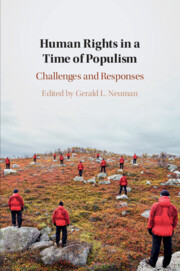Book contents
- Human Rights in a Time of Populism
- Human Rights in a Time of Populism
- Copyright page
- Contents
- Contributors
- Preface
- Acknowledgments
- 1 Populist Threats to the International Human Rights System
- 2 US Human Rights Policy and the Trump Administration
- 3 Rule-of-Law Rights and Populist Impatience
- 4 Populism and Human Rights in Poland
- 5 The Legal Architecture of Populism
- 6 Representation, Paternalism, and Exclusion
- 7 Penal Populism in Emerging Markets
- 8 The Populist Threat to Democracy in Myanmar
- 9 In Defense of Democratic Populism
- 10 Populism and International Human Rights Law Institutions
- 11 Human Rights Responses to the Populist Challenge
- Index
- References
8 - The Populist Threat to Democracy in Myanmar
Published online by Cambridge University Press: 22 April 2020
- Human Rights in a Time of Populism
- Human Rights in a Time of Populism
- Copyright page
- Contents
- Contributors
- Preface
- Acknowledgments
- 1 Populist Threats to the International Human Rights System
- 2 US Human Rights Policy and the Trump Administration
- 3 Rule-of-Law Rights and Populist Impatience
- 4 Populism and Human Rights in Poland
- 5 The Legal Architecture of Populism
- 6 Representation, Paternalism, and Exclusion
- 7 Penal Populism in Emerging Markets
- 8 The Populist Threat to Democracy in Myanmar
- 9 In Defense of Democratic Populism
- 10 Populism and International Human Rights Law Institutions
- 11 Human Rights Responses to the Populist Challenge
- Index
- References
Summary
Despite the election of a civilian government in Myanmar in 2015 – the first since 1962 – the transition from military rule to human rights-respecting democratic governance remains a major work in progress. This chapter examines the sociopolitical causes of current populist tensions in Myanmar, such as the historical roots of ultra-nationalism and militarization, which extend back to the country’s colonial past. Persistent military offensives against ethnic and religious minorities, most acutely against the Muslim Rohingya population, are supported by a populist culture of intolerance that not only threatens persecuted communities but places the future of democracy in Myanmar at risk. The stoking of violence in the Rohingya crisis is also linked to radical “Buddhist” organizations, including the 969 and MaBaTha (Race and Religion Protection Committee). The chapter closes by examining how the international community and human rights systems can still contribute to developing an inclusive, human-rights-based culture in Myanmar.
- Type
- Chapter
- Information
- Human Rights in a Time of PopulismChallenges and Responses, pp. 164 - 191Publisher: Cambridge University PressPrint publication year: 2020
References
- 4
- Cited by

